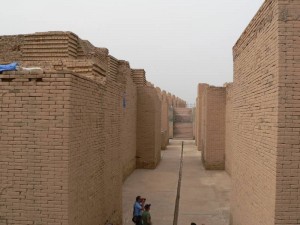- South Korea
- Taiwan
- Philippines
- Nepal
- Sri Lanka
- Israel
- Cambodia
- Vietnam
- Laos
- Myanmar
- Oman
- United Arab Emirates
- Qatar
- Kuwait
- Bahrain
- Thailand
- Syria
- Jordan
- Lebanon
- Iran
- Yemen
- Tajikistan
- Turkey
- Turkmenistan
- Uzbekistan
- Kyrgyzstan
- India
- Bangladesh
- Bhutan
- Malaysia
- Brunei
- Armenia
- Azerbaijan
- Georgia
- Saudi Arabia
- Mongolia
- Singapore
- East Timor
- North Korea
- Iraq
- Afganistan
- Pakistan
- Japan
- Okinawa dep. Japan
- Palestine dep. Israel
- Hong Kong dep. China
- Irian Jaya dep. Indonessia
- Kashmir dep. India
- Macao dep. China
- Nakhichevan dep. Azerbaijan
- Siberia dep. Russia
- Sikkim dep. Indie
- Tibet dep. China
- Indonesia
- China
- Abkazia dep. Georgia/Russia
- Kazakhstan





Saturday, March 16, 2013 – Babylon, Iraq
I am on a 14-day tour of Iraq with a group of 15 intrepid travelers. The main goals of our journey are on one side the excavations of the ancient cultures in the southern Mesopotamia and on the other side the holy Shiites places between Basra and Baghdad. After a morning tour of Karbala, one of the Shiites holy cities, there is a pearl of the ancient Mesopotamia, Babylon, on schedule for the afternoon.
Upon arrival to excavations of Babylon, we pass underneath one of the many Saddam palaces standing on an artificial hill above the area. We stop at the sentry-box. After ten minutes explaining we get permission to see the sights. In the parking lot, where we get off our bus, we meet the French group we saw in Nasiriyah. They are the only tourists in Iraq beside us. The sun shines through the haze made of fine sand scattered in the air.
We enter Babylon through a large gate, built in 1958. It resembles the original gate of the goddess Ishtar, which once stood in another city location. Germans, while working on excavations at the beginning of the 20 century. dismantled the ancient gate and transported it to a Berlin museum, where they put it back together again. I saw it there during my Berlin visit in 2003. Behind this 1958 “Ishtar Gate” Saddam Hussein built his imaginary Babylon (Babylon make believe) on the real city foundations. According to archaeologist Geoff Emberling from one American university, who is accompanying us, Saddam’s Babylon has no historical value, because nobody knows how the original buildings looked like.
Read more
TK-12 Eastern TURKEY, Kurdistan (part of IRAQ)
Date of travel: May 7 – May 28, 2012
ITINERARY:
On May 7, 2012 at noon I fly on Turkish Airlines from Prague, Czech Republic to Istanbul, TURKEY. I land there in midafternoon. A van takes me to hotel in center of the city. Here I meet the rest of our group.
Next day early in the morning we fly from Istanbul to Erzurum in eastern Turkey. By bus to our hotel outside the city. A city tour starts before noon. We visit the “Grand Mosque,” a madrasa, and Royal Tombs. After lunch we see more mosques, a museum, and “Tas Hani” caravanserai. Final stop is at a jewelry store.
In the morning on May 9 we drive by bus from Erzurum through a wild mountainous region to Kars near Armenian border where late afternoon. Russian tsars and Ottomans fought about this place 4x. Some houses were built by Russians, some by Turks. There is a visit to the 10th century “Church of Apostles” changed to a mosque. There is a fort above the city. The streets are full of mainly young people. Overnight in a hotel.
After leaving Kars the following day, we stop at excavations of “Ani.” About 1000 years ago it was a capital of Armenia. Earthquake destroyed it. After lunch, we visit caves of an active salt mines. We pass through the town of Igdir under the famous Ararat Mountain. From here it is close to town Dogubayzit. Near this town we explore Ishak Pasha Palace. We stay in a local hotel.
Read more
IQ-13 IRAQ
Date of travel: Mar 8 – Mar 21, 2013
ITINERARY:
On Mar 8 in the evening I fly from Prague, Czech Republic to Istanbul, Turkey. Here I join our traveling group. There is a problem to get on the plane to Iraq, because our group does not have visas to Iraq. The last minute we board the plane and early in the morning on Mar 9 we land in Basra, IRAQ.
The same day with our military escort we visit the confluence of Euphrates and Tigris Rivers. Later we sightsee Basra then go to our hotel. The following day we see the excavations of Sumerian city Ur with its famous ziggurat. Later on we come to the Shiite city Nasiriya where overnight following 3 nights. Next day we take a boat ride in marches which Saddam Hussein tried to dry up to stop local Arabs insurrection. On Mar 12 we visit with an Iraqi archeologist Nigiris and the ancient Lagash. First stop is in Nigiris where the French were digging in 1887-8. The Lagash itself we see later in the afternoon. It’s a field covered by pieces of pottery. We may examine them but we must leave them there. The following day we leave Nasiriya. At noon we reach excavations of Uruk. Most of us claimb its ziggurat. By night we are in the Shiite holy city Najaf. Women of our group get to wear black overcoat “abaija” in holy places. Next morning we see the nearby holy city of Kufa. In the afternoon back to Najaf to visit a shrine with grave of Ali, relative of Muhammad, and the reason why Muslims split in Sunni and Shi’a.
Read more
